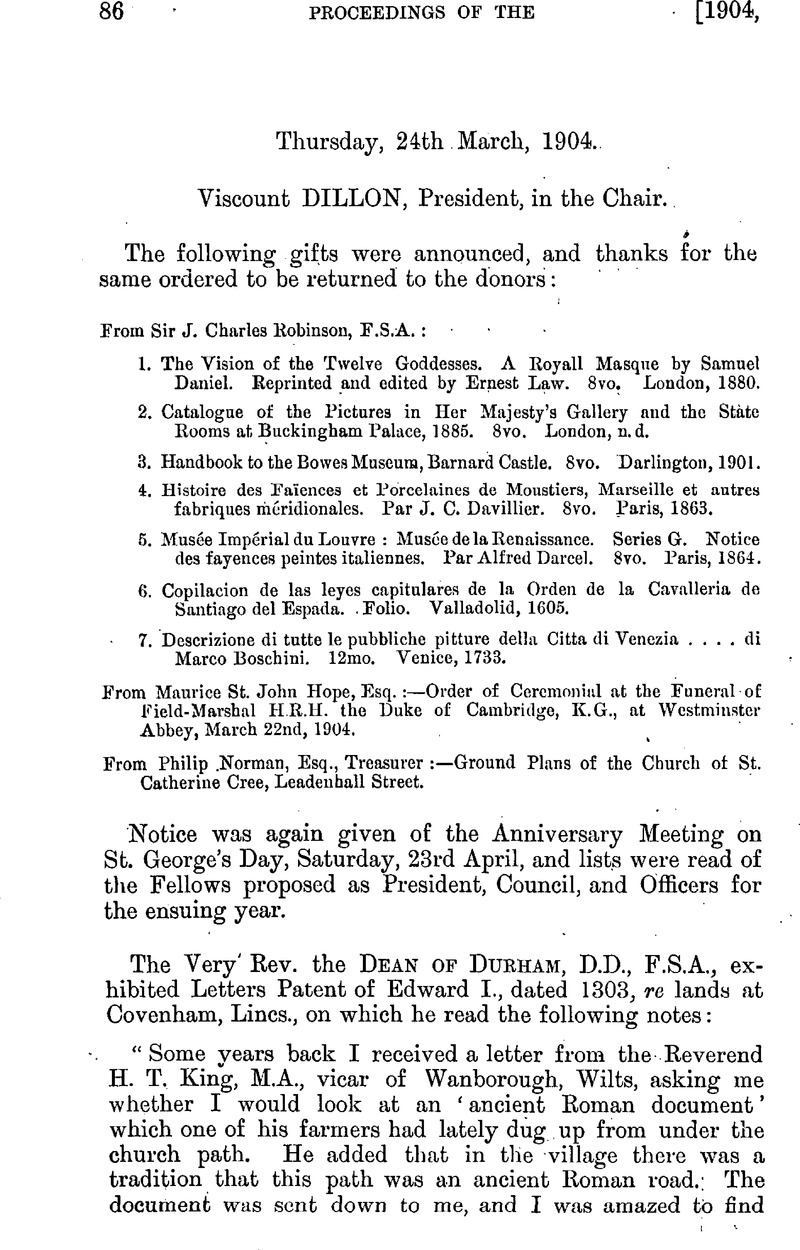No CrossRef data available.
Article contents
Thursday, 24th March, 1904
Published online by Cambridge University Press: 10 May 2010
Abstract

- Type
- Proceedings
- Information
- Proceedings of the Society of Antiquaries of London , Volume 20 , Issue 1 , June 1905 , pp. 86 - 105
- Copyright
- Copyright © The Society of Antiquaries of London 1905
References
page 88 note * Stubbs, C. E. ii. 115.
page 88 note † And when be kyng, be be meanes aforsaid or ober wyse, hath gotyn agen his lyvelod, yff then it wolde lyke is most noble grace to establysh, and, as who sayth amortyse be same lyvelod to is crowne, so as it mey neuer be alyened berfro, withowt pe assent off his Parlement, wych than wold be as a newe ffundacion of is crowne, he shall be berby the grettest ffounder off be world.” Then, after enlarging on the advantages, Fortescue breaks forth into prophecy. “And trewly yff be Kyng do this, he shall do berby dayly more almes, ban shall be do be all the ffundacions bat euer wore made in Englond. Ffor euery man off be lande shal by this ffundacion, euery day be be meryer, be surer, ffare be better in is body and all is godis as euery wyse man mey well conseyve. The ffundacion of abbeys, of hospitals and suche ober houses, is nothyng in comparisoun herof. For this shalbe a collage in whiche shul syng and pray for euermore al be men of Ingland spirituel and temporal. And ther song shalbe suche among ober autemes : I Blissed be oure Lord God, for that he hath sent Kyng Edward the iiij to reigne upon vs. He hath don more for vs, than euer dide Kyng of Inglond, or myght have don before hym. The harmes that hath fallen in getyng of his Realme beth now bi hym turned into our altheyr goode and profite. We shul nowe mowe enjoye oure owne goode and live vuder justice, which we have not don of longtyme, God knowyth. Wherfor of his almesse it is that wee have al that is in oure wono.”—Governance of England, ed, Plummer, 154–156.
page 89 note * See Calendar, 31 Edw. I., pp. 149, 150.
page 89 note † St. Carileph (or St. Calais now) was the name given to the town, after the saint had there founded his abbey, in the sixth century. The town, on the banks of the little tributary the Anille, was first called Anisola, or Anille ; when the village grew into a country town round the monastic buildings it took the saint's name instead. It is now the chef lieu of the arrondissement (Sarthe).
page 92 note * Bulletin de la Société nationale des Antiquaires de. France, 1902, pp. 281f.
page 92 note † The bars have since been acquired by the British Museum.
page 92 note ‡ Dr. Rubensohn gives the weight (at second hand) as 240 grammes; possibly a misprint for 340.
page 92 note § Dr. Dressel, of the Berlin Museum, differs from me in reading the fifth letter from the end as V instead of N.
page 93 note * Arch.-Epigr. Mittheilungen aus Oesterreich-Ungarn, xii. pp. 1 ff., 66 Num. Zeitschr. 1888, pp. 19–46 ; Zeitschr. f. Num. xvi. pp. 351 ff.; C. I. L. III. Suppl. 8080 ; Num. Zeitschr. 1898, pp. 211–235, 1899, p. 38 ; Willers, Die Römischen Bronzeeimer von Hemmoor (1901), pp. 228 ff.
page 94 note * Willers prefers the date 393–395 (under Theodosius the Great and his two sons, Arcadius and Honorius).
page 94 note † Willers, Die Bronzeeimer, p. 230, thinks that they too were probatores ; that they actually tested the bars, and Lucianus confirmed their decision, thus giving the bars an official character.
page 94 note ‡ The use of such bars in commerce at a later period is proved by the passage quoted by Willers (loc. cit.) from Paulus Diaconus. An army of Saxons who had invaded Italy with the Lombards moved about 574 into Southern France. On their way they cheated many people by passing off as gold copper bars (regulae aeris) which were so ‘coloured,’ ut auri probati atque examinati speciem, simularent. For corresponding silver bars from Dierstorf (Kreis Stolzenau), see Willers, pp. 231ff.
page 96 note * Kenyon, Greek Papyri in the British Museum, ii. 257 ff. I owe this reference to Mr. Kenyon.
page 96 note † C. I. L. xv. 6878, 6886. I owe this and the succeeding reference to Mr. H. B. Walters.
page 96 note ‡ C. I. L. xv. 5211, 5398.
page 96 note § Cp. the instances given under aurum (9) in Forcellini.




